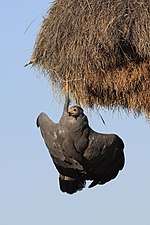African harrier-hawk
The African harrier-hawk, harrier hawk or gymnogene (Polyboroides typus) is a bird of prey. It is about 60–66 centimetres (24–26 in) in length. It breeds in most of Africa south of the Sahara. The only other member of the genus is the allopatric Madagascan harrier-hawk (Polyboroides radiatus).
| African harrier-hawk | |
|---|---|
 | |
 | |
| Adult, settled on sand bank and in flight | |
| Scientific classification | |
| Kingdom: | Animalia |
| Phylum: | Chordata |
| Class: | Aves |
| Order: | Accipitriformes |
| Family: | Accipitridae |
| Genus: | Polyboroides |
| Species: | P. typus |
| Binomial name | |
| Polyboroides typus Smith, 1829 | |
Description
The African harrier-hawk is a medium-sized raptor. The upperparts, head and breast are pale grey. The belly is white with fine dark barring. The broad wings are pale grey with a black trailing edge fringed with a narrow white line. The tail is black with a single broad white band. There is a bare facial patch of variable colour, usually red or yellow. Genders are similar, but young birds have pale brown instead of grey, and dark brown replacing black. An unusual trait of this species is the double-jointed knees it possesses, which enable it to reach into otherwise inaccessible holes and cracks for prey. A comparable leg-structure and behaviour can be found in the Neotropical crane hawk; a case of convergent evolution.
The call is a whistled sueee-sueee-sueee.
Habitat
The African harrier-hawk can be found in natural woodland, tree plantations and urban areas.
Biology
It builds a stick nest in the fork of a tree or the crown of a palm tree. The clutch is one to three eggs.
The African harrier-hawk is omnivorous, eating the fruit of the oil palm as well as hunting small vertebrates. Its ability to climb, using wings as well as feet, and its long double-jointed legs, enable this bird to raid the nests of cavity-nesters such as barbets and woodhoopoes for eggs and nestlings. It has been known to prey on introduced species such as feral pigeons, house sparrows and eastern gray squirrels.[2][3]
Gallery
_(21646641084).jpg) Immature bird in flight, Zambia
Immature bird in flight, Zambia%2C_Polyboroides_typus%2C_at_Ndumo_Nature_Reserve%2C_KwaZulu-Natal%2C_South_Africa_(28901676521).jpg) Immature bird lifting tree bark, South Africa
Immature bird lifting tree bark, South Africa_taking_off%2C_crop.jpg) Adult alighting from a perch, Zimbabwe
Adult alighting from a perch, Zimbabwe.jpg) Adult investigating a tree cavity, Kenya
Adult investigating a tree cavity, Kenya_in_flight_with_African_harrier-hawk_(Polyboroides_typus)_composite.jpg) Adult soaring alongside a martial eagle (Polemaetus bellicosus), Zimbabwe
Adult soaring alongside a martial eagle (Polemaetus bellicosus), Zimbabwe
References
- BirdLife International (2012). "Polyboroides typus". IUCN Red List of Threatened Species. 2012. Retrieved 26 November 2013.CS1 maint: ref=harv (link)
- Little, Rob. "Lighting Strike: African Harrier-Hawks in Cape Town" (PDF). Archived from the original (PDF) on 2014-01-03. Retrieved 29 June 2013.
- "Polyboroides typus (African harrier-hawk, Gymnogene)". Archived from the original on 3 November 2013. Retrieved 29 June 2013.
- Birds of The Gambia by Barlow, Wacher and Disley, ISBN 1-873403-32-1
External links
- (African harrier-hawk = ) Gymnogene - Species text in The Atlas of Southern African Birds

